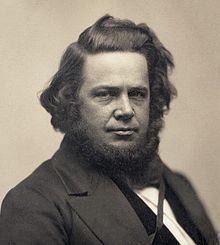Elias Howe
| Elias Howe Jr. | |
|---|---|
 |
|
| Born |
July 9, 1819 Spencer, Massachusetts |
| Died | October 3, 1867 (aged 48) Brooklyn, New York |
| Nationality | American |
| Education | apprenticed as mechanic and machinist |
| Spouse(s) | Elizabeth Jennings Ames (m. 1841; d. 1850) Rose Halladay (d. 1890) |
| Children | Jane Robinson Howe, Simon Ames Howe, Julia Maria Howe |
| Parent(s) | Elias Howe and Polly (Bemis) Howe |
| Engineering career | |
| Discipline | Mechanical Engineering |
| Projects | sewing machine |
| Significant advance | lockstitch loop method |
| Awards | Gold Medal, Paris Exposition of 1867, Légion d'honneur (France) |
Elias Howe, Jr. (/haʊ/; July 9, 1819 – October 3, 1867) was an American inventor and sewing machine pioneer.
Elias Howe, Jr. was born on July 9, 1819, to Dr. Elias Howe, Sr., and Polly (Bemis) Howe in Spencer, Massachusetts. Howe spent his childhood and early adult years in Massachusetts where he apprenticed in a textile factory in Lowell beginning in 1835. After mill closings due to the Panic of 1837, he moved to Cambridge, Massachusetts, to work as a mechanic with carding machinery, apprenticing along with his cousin Nathaniel P. Banks. Beginning in 1838, he apprenticed in the shop of Ari Davis, a master mechanic in Cambridge who specialized in the manufacture and repair of chronometers and other precision instruments. It was in the employ of Davis that Howe seized upon the idea of the sewing machine.
He married Elizabeth Jennings Ames, daughter of Simon Ames and Jane B. Ames on 3 Mar 1841 in Cambridge. They had three children: Jane Robinson Howe, Simon Ames Howe, and Julia Maria Howe.
Contrary to popular belief, Howe was not the first to conceive of the idea of a sewing machine. Many other people had formulated the idea of such a machine before him, one as early as 1790, and some had even patented their designs and produced working machines, in one case at least 80 of them. However, Howe originated significant refinements to the design concepts of his predecessors, and on September 10, 1846, he was awarded the first United States patent (U.S. Patent 4,750) for a sewing machine using a lockstitch design. His machine contained the three essential features common to most modern machines:
A possibly apocryphal account of how he came up with the idea for placing the eye of the needle at the point is recorded in a family history of his mother's family:
...
Wikipedia
